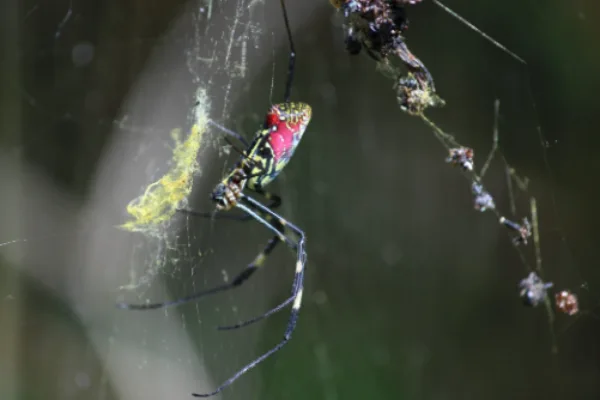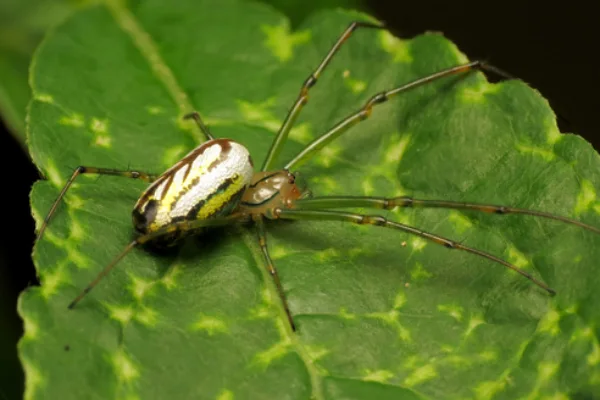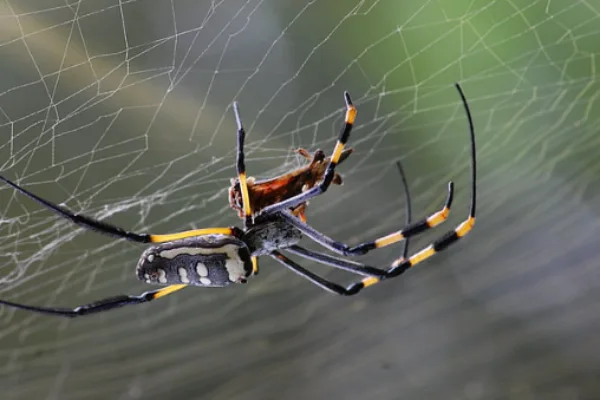We all love the bright yellow sun in the morning, and once on such a bright morning, I saw a yellow and black spider in the bushes making its web. That’s a Joro spider. The spider has yellow and blue strips with red patches on the sides of the abdomen. As we all know, America is the home of so many species of spiders, so today we are going on a mission to explore the species of black and yellow spiders native to America.
Which black and yellow spider is venomous?
As we all know, some spiders are highly venomous and can cause death and paralysis. But you might think that yellow and black spiders are venomous or not. Or their venom can affect humans.
So here is the answer: no, the yellow and black spiders are mostly garden spiders that are not so highly venomous that their venom can cause serious injury or death.
Their venom is mild and can cause skin irritation, redness, and swollen bites. Because of their low toxicity level, their venom is not dangerous to humans.
10 Black and Yellow Spiders Native To The Americas
1. Black and yellow garden spiders

| Scientific name | Argiope aurantia |
| Size | 19-28 mm |
| Identification | White cephalothorax |
| Geographical location | Central America |
Black and yellow garden spiders have a lot of names, like the golden garden spider, black and yellow Argiope, steeler spider, and McKinley spider.
The spider has beautiful yellow and black markings on the abdomen and a white color on the cephalothorax. Do you know this spider species grows from 19 to 28 mm?
Of course, this spider is native to America, but you can also find this species of spider on the islands of Hawaii, Canada, and Mexico. Talking about its toxicity and behavior, this spider is of a non-aggressive nature, and its venom is not allergic to humans.
2. Black-footed spider
| Scientific name | Cheiracanthium inclusum |
| Size | 4-9 mm |
| Identification | Black stripe on legs |
| Geographical location | north, central and south America |
Another spider on the list is the black-footed spider. This spider has a yellow-beige cephalothorax and abdomen with dark brown or black palps.
Also, the chelicerae and feet are black. In terms of body length, this spider ranges from 5–9 mm in females and 4–8 mm in males.
Although you can differentiate between male and female spiders, males have narrow bodies and long legs as compared to females. Also, the most interesting feature of this spider is that it has a longer front pair of legs than the other three pairs of legs.
3. Joro spider

| Scientific name | Trichonephila clavata |
| Size | 7-25 mm |
| Identification | Red patches on each side of the abdomen |
| Geographical location | north America, Georgia, and South Carolina |
Now let’s talk about a species that was introduced to America and has now become a native of the country. That’s none other than the Joro spider, scientifically known as Trichonephila clavata.
Firstly, this spider was founded in 2014 in North America, but later in 2022, it spread to the regions of Georgia, South Carolina, North Carolina, and Tennessee, with additional reports in Alabama, Maryland, Oklahoma, and West Virginia.
This is how this species became a family member of American spiders. Now let’s talk about its appearance. The spider has a yellow abdomen with dark blue stripes and red patches on the sides.
Other than that, the spider has black legs with yellow spots. The male spider can grow 7–10 mm, while the females can reach a length of 17–25 mm.
You might be thinking that this spider is venomous, but its bite can cause skin irritation and pain. But not to life, and the spider prefers to live in peace.
4. Phylloneta Pictipes
| Scientific name | Phylloneta Pictipes |
| Size | Approx. 15 mm |
| Identification | Black band on the carapace |
| Geographical location | North, Central and South America |
Another black and yellow spider native to America is Phylloneta Pictipes. This species of spider has a yellow carapace with a shade of white on which a black band moves across its body length.
Along with this, the black border moves narrowly around the carapace. Further, the legs of the spider are yellow in color and have black color bands. Mostly, this tiny spider can grow approximately 15 mm.
5. Arrow-shaped micrathena
| Scientific name | Micrathena sagittata |
| Size | 5-9 mm |
| Identification | Arrow-shaped abdomen |
| Geographical location | Central America |
Arrow-shaped micrathena is scientifically named Micrathena sagittata. As its name suggests, the spider has a yellow-colored, arrow-shaped abdomen.
The abdomen has a black and red impression on it. Also, the spider has six tubercles at the end of the abdomen with a black tip and red base. This uncommon red, black, and yellow spider can grow to a maximum length of 9 mm in females and 5 mm in males.
6. Spiny-backed orb weaver spider
| Scientific name | Gasteracantha cancriformis |
| Size | 5-13 mm |
| Identification | Three pairs of spines at the abdomen |
| Geographical location | North America, Central America, the Caribbean and South America |
The spiny-backed orb weaver spider, also known by the name Gasteracantha cancriformis, has six abdominal spine-like projections.
Talking about their appearance, they have a black carapace, legs, and underside with yellow spots. The upper sides can be white or yellow, with black spots on both sides.
Male spiders are smaller and longer than females. Female spiders are 5–9 mm long and 10–13 mm wide. You can easily identify this spider, as it has six black abdominal spines.
7. Western spotted orb weaver spider
| Scientific name | Neoscona oaxacensis |
| Size | 9-18 mm |
| Identification | Slender abdomen |
| Geographical location | South America |
Neoscona oaxacensis, also known as the western spotted orb weaver or zig-zac spider, is a spider species in the Araneidae family, found in the Americas from Kansas and California to Venezuela and Peru, including the Galápagos Islands.
It is relatively large, with females measuring 9–18 mm in length and males being smaller.
The spider’s black-and-white pattern on the upper surface is distinctive, and South American specimens have a slender abdomen with a distinct light central band with a wavy border.
Females have an epigyne 2.5 times as long as wide, and males have a palp with an S-shaped conductor.
8. Orchard spider

| Scientific name | Leucauge venusta |
| Size | 3.5-7.5 mm |
| Identification | Silver top with black streaks and yellow spots |
| Geographical location | Central America |
Leucauge venusta, also known as the orchard orbweaver spider, is a long-jawed spider found in southern Canada, Colombia, the East Coast, the central US, and South Asia.
Its distinctive coloration includes leaf-green legs and sides, yellow and black thorax spots, a silvery top with brown and black streaks, and neon yellow, orange, or red spots on the abdomen.
9. Golden silk orbweaver

| Scientific name | Trichonephila clavipes |
| Size | 24-40 mm |
| Identification | Silvery-white cephalothorax and an orange-brown abdomen with white-yellow spots |
| Geographical location | Florida, south eastern and north America |
Trichonephila clavipes, also known as the golden silk orb-weaver or golden silk spider, is an orb-weaving spider species found in forests and wooded areas in the United States and Argentina.
Females of this species are some of the largest non-tarantula spiders in North America, ranging from 24 mm to 40 mm in length.
They have distinct coloring, including a silvery-white cephalothorax and an orange-brown abdomen with white-yellow spots.
As they mature, their abdomen changes color and their legs feature dark yellow and brown banding and black brush-like tufts of hair near the joints.
10. Barn spider
| Scientific name | Araneus cavaticus |
| Size | Approx. 20 mm |
| Identification | Round abdomen |
| Geographical location | North America |
The barn spider, a common orb-weaver spider native to North America, is predominantly yellow and brown in color.
With striped legs and black undersides, they can grow up to and above an inch in length. Their large, round abdomens can vary in color range, but they are typically yellow and brown in color.
Conclusion:
Here we come to an end. In the American landscape, you might come across these charming black and yellow spiders. They’re adorable and beautiful, and the good news is they’re harmless too. The most common spiders you can find around America are black-footed spiders, Argiope aurantia, etc.
Spiders have such a large society that you can definitely encounter them anywhere. If you want to learn more about spiders in the world, then follow us on How It See.
Reference:
- Wikipedia
- AtoZ animals
- Bug guide
Also Read:

As a content writer, I like to write about different niches. I have a curiosity about nature and animals. And like to learn about them. Through my writing, I like to share my experience and knowledge with you. I hope you are enjoying it too.
